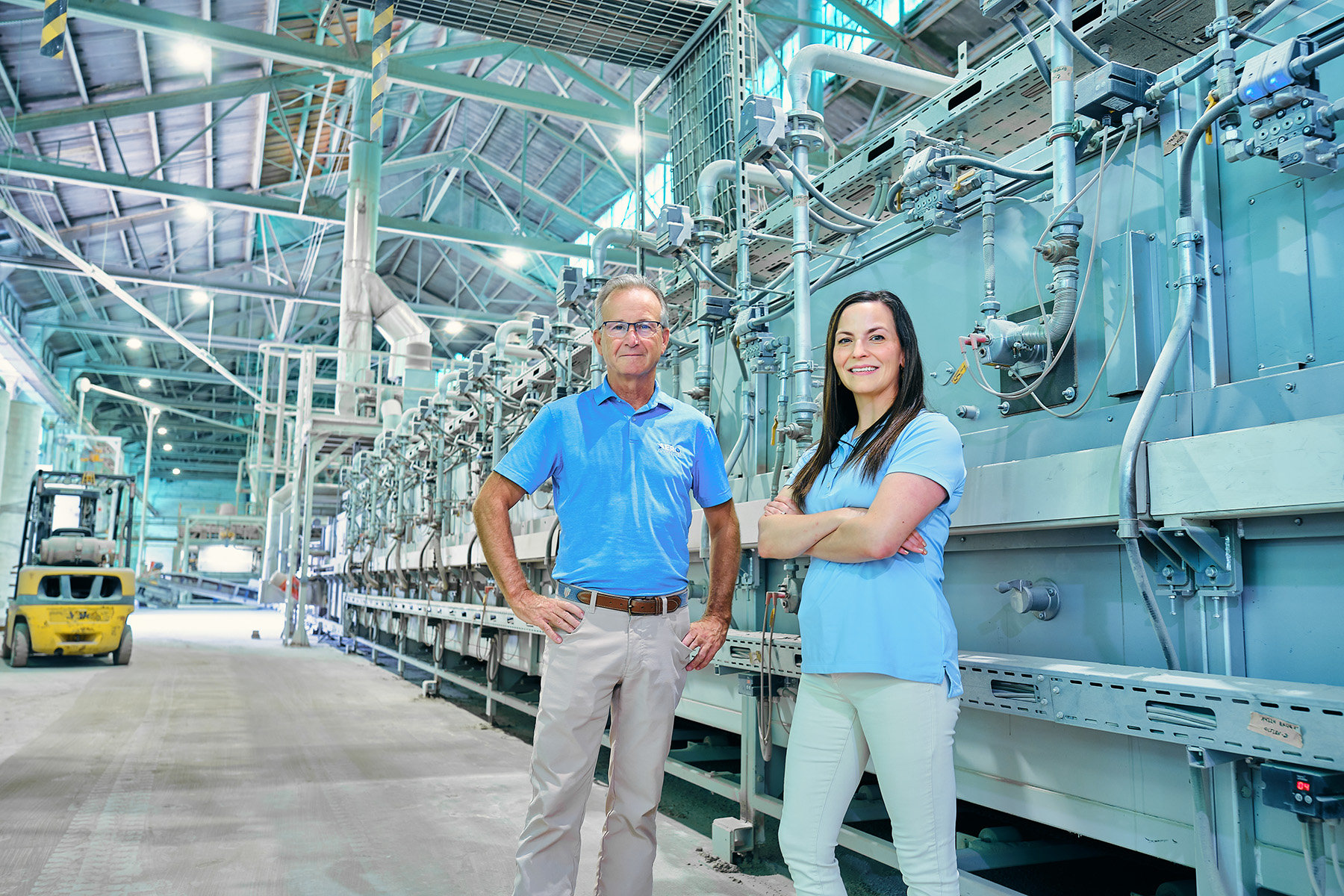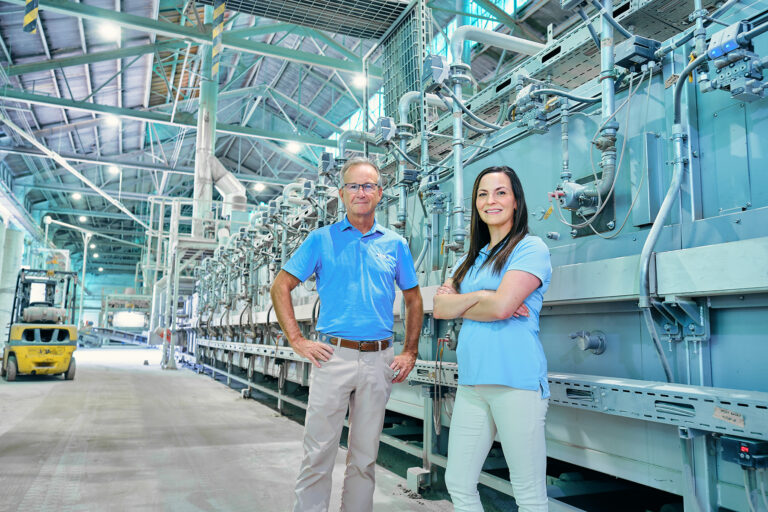
Filshill and Loux stand next to the kiln inside the Aero Aggregates plant in Eddystone, Pennsylvania.
Photo: Jeff Fusco
The collapse of an Interstate 95 bridge in northeast Philadelphia in June 2023 sparked dire forecasts of a crippled regional economy, a tangled supply chain and commuting chaos for months on end.
The soothsayers clearly didn’t know about Archie Filshill (MS civil engineering ’96, PhD civil engineering ’11) or Theresa Andrejack Loux (BS civil engineering ’06, MS civil engineering ’06, PhD civil engineering ’10). But they would soon learn.
The CEO and CTO, respectively, of Aero Aggregates of North America helped avert prolonged calamity on a key transit artery for the entire Eastern Seaboard.
Some 8,000 cubic yards of foamed glass aggregate that Aero produces from recycled bottles and jars provided backfill that crews paved over, allowing six of the interstate’s eight lanes to reopen just 12 days after the bridge fell.
For their role in reopening the interstate so quickly, Aero’s two principals earned prominent spots in a celebratory parade and a standing ovation at a Phillies game.
“As a Northeast Philly guy, that was a big deal,” says Filshill, who also personally briefed Gov. Josh Shapiro and President Joe Biden on the properties of the foamed glass aggregate when the interstate reopened.
Aero’s sudden stardom actually grew from seeds planted at Drexel decades before, when the late Robert Koerner — himself a double Dragon — helped establish the field of geosynthetics, which are man-made materials used in combination with soil or rock to improve one or more of the properties of these earthen materials.
A member of the College of Engineering Department of Civil Engineering and the Bowman Professor of Engineering until his death in 2019, Koerner wrote “Designing with Geosynthetics,” a landmark textbook that led to the design and installation of polymeric “fabrics” that are widely used today on projects related to roadways, retaining walls, airfields, dams and agriculture. Geosynthetics have become a standard in the United States for construction of landfills and mechanically stabilized earth-retaining walls.
Filshill heard about Koerner during his undergraduate days at Temple University and decided to take some classes at Drexel.
“How do you not at least take a couple of classes with the world expert, when he’s in your same hometown?” Filshill asks. “So, I took his classes and then some more classes, and that’s how I got my master’s degree.”

Archie Filshill ’96, ’11 and Theresa Andrejack Loux ’06, ’10
After spending five years working in Europe, Filshill met Loux while both pursued their PhDs. The geotechnical engineers’ shared interests kept them connected until they completed their doctoral studies, when their paths diverged. She taught at Bucknell University, while he continued to grow a construction business he founded that was focused on geo-environmental design-build projects.
A couple of years later, Filshill bumped into Loux, who was ready for a change from academia, and he hired her as a project engineer.
During his stint overseas, Filshill learned how engineers there had begun using foamed recycled glass in construction projects. Discarded bottles and jars are cleaned, milled into a fine powder and mixed with a foaming agent before emerging from a kiln in sheets that break into gravel-like chunks.
The lightweight material makes it ideal for construction on soft soils and for protecting underground utilities, such as water and sewer lines. Its insulating, insect-resisting and non-flammable properties also make it useful in residential and commercial construction.
And, unlike plastic or paper, recycled glass is a predictable commodity.
“It’s very consistent,” Filshill says, observing that engineers typically greet recycled materials with a raft of questions. “‘Where did the plastic come from? Where did the paper come from? Was there contamination?’ Once you get the glass clean, it’s glass.”
Filshill envisioned additional uses for foamed glass aggregate and obtained two patents, the first reflecting his recognition that — when floated over the surface of a water or sewage lagoon — the permeable material lets rainwater in but blocks evaporation, reducing odors. His discovery that the material’s insulating properties can prevent landfill-generated heat from damaging the geomembrane covers laid over them led to a second patent.
After launching Aero, Filshill invited Loux to join the company as the technical lead. Loux’s expertise in research has enabled Aero to explore yet more uses for foamed glass aggregate, and the company now has eight patents pending. She also oversees quality control and leads efforts to educate the engineering and construction community about material that is still relatively uncommon in the United States.
The region’s critical mass of Drexel-trained engineers has opened doors for the company. Aero has supplied aggregate for some 300 projects, including a new apron at Philadelphia International Airport; a temporary ramp at JFK Airport; the Nassau Expressway connecting New York City to Long Island; a stretch of I-95 outside Fredericksburg, Virginia; and the I-395 connector near Bangor, Maine.
Aero’s local reputation made it an obvious choice for the I-95 rebuild.
PennDOT engineers summoned to the site called Filshill within two hours of the collapse to ask if he had enough product.
Moments later, Filshill fielded the same question from Rob Buckley, the son of Bob Buckley, ’58, HD ’12, an emeritus trustee who had received word that his family firm, Buckley & Co., would be tapped to serve as general contractor to manage the emergency project.
As the sole North American manufacturer of dry-process closed-cell foamed glass aggregate, Aero was poised for tremendous growth, even before its recent burst of fame. The company now has three production lines in Eddystone, while a plant with two production lines opened in Florida in 2022 and a facility with two more production lines will open in California before the end of 2023.
That plant, in Modesto, will be run in partnership with Halo Recycling, a subsidiary of Gallo Wines.
“They’re going to be a great partner for us, and hopefully, they feel the same way,” Loux says. “We should be able to take all of the off-spec glass that they can’t use in their bottling operations.”
For Filshill and Loux, providing American builders with an aggregate suited to diverse applications was a promising prospect from the start. That it can be produced economically made it that much better.
By making it from recycled material, Aero has achieved an engineering trifecta.
“As a company last year — and this is probably a big one for us — we’ve diverted the equivalent of over a half a billion bottles from landfills,” Filshill says. “And when California opens, that’ll be what we’ll be doing, per year, with the three facilities.”
“We’re constantly trying to explore new applications or modifying our product.”
— Theresa Andrejack Loux
Filshill and Loux are now advancing sustainability in other ways, says Grace Hsuan, a professor in the College of Engineering Department of Civil, Architectural and Environmental Engineering who formerly taught both.
In 2018, Hsuan notes, Filshill served as a consultant to Associate Professor Yaghoob Amir Farnam, enabling him to secure a pivotal National Science Foundation I-Corps grant as well as a recent Innovation Fund grant from Drexel to develop a scalable lightweight aggregate manufacturing technology using waste ash left over from coal combustion.
More recently, Filshill and Loux have helped Hsuan and engineering colleagues with their study of a lightweight concrete aggregate that incorporates coal ash, foamed glass and composite, for which the College of Engineering conferred a Longsview Fellowship.
Along the way, Hsuan says, her former students have created a valuable model.
“Removing waste from the landfill and making it into valuable construction material — I think that is a fantastic example of a circular economy,” Hsuan says, praising the two engineers for taking the time to lead seminars for her first-year students.
The admiration cuts both ways. As Filshill prepared to open the Aero plant, there was one visit he had to make.
“The first bag of rocks, we took back to Drexel,” Filshill recalls. “We had a couple of professors start working on it and testing it. But it’s also been a place you can call and say, ‘Hey, we’d like to grab a cup of coffee’ and just have these roundtable discussions. Drexel has been very good that way.”


